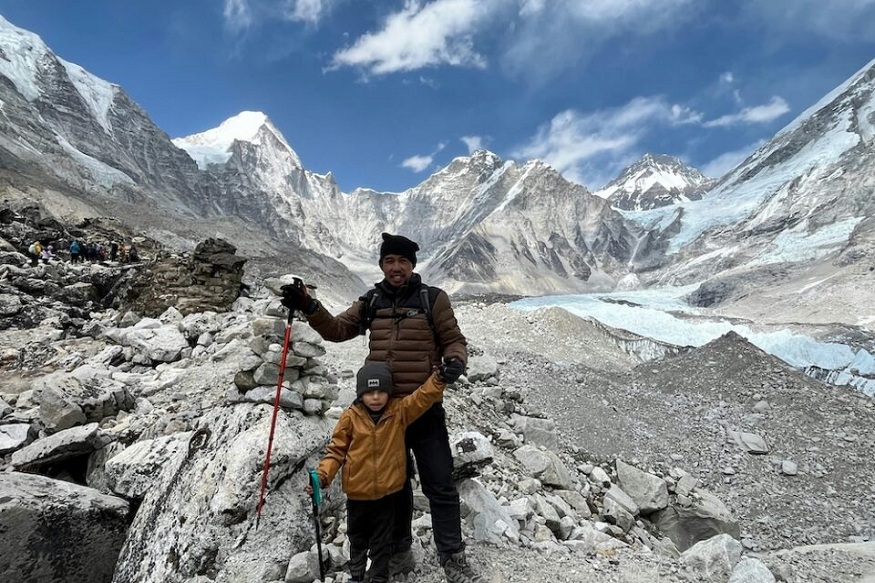 The Everest Base Camp (EBC) is an adventure of a lifetime, a fantastic combination of scenic splendor and rich cultural experience, and the core of its charm comes from its people – the Sherpas – the tough people who have resided in the vicinity of Everest for generations. The Sherpas are not simply guides, but the protectors of the Khumbu, and their understanding of the landscape, of the weather, of the religious life of those mountains. They’re practically a godsend in the EBC trek. They provide logistical support and share their culture, tradition, the story of the Himalayas, and ultimately bring texture to the journey beyond what words can convey.
The Everest Base Camp (EBC) is an adventure of a lifetime, a fantastic combination of scenic splendor and rich cultural experience, and the core of its charm comes from its people – the Sherpas – the tough people who have resided in the vicinity of Everest for generations. The Sherpas are not simply guides, but the protectors of the Khumbu, and their understanding of the landscape, of the weather, of the religious life of those mountains. They’re practically a godsend in the EBC trek. They provide logistical support and share their culture, tradition, the story of the Himalayas, and ultimately bring texture to the journey beyond what words can convey.
Challenge aside, the trek itself is a mesmerizing odyssey through a realm of sky-scraping snow-peaked Himalayas, craggy ridges, gushing glacial rivers, and alpine meadows. You’ll ascend through villages like Lukla, Phakding, and Namche Bazaar, and your senses will be awakened to the sights and sounds of Sherpa life: prayer flags flapping in the wind, the distant stream of monks’ chanting, the smell of yak butter tea. The mountains themselves, and especially Everest, Lhotse, and Ama Dablam, will overpower the skyline and be constant companions during your trek.
The closer you get to base camp, the more dramatic the scenery will be. Its views are harder won as the path gets steeper and more demanding. Getting to EBC is an experience that is spiritual and psychological, all at the same time, standing there at the base of the highest peak of the world with its glaciers and ice falls and the untouched beauty of the mountains of the Himalayas. The snowcapped mountains are awe-inspiring, and each step toward base camp is one step nearer in spirit to the Sherpa and their mountains.
The Sherpas and snow peaks combine to deliver (in my opinion) the ultimate EBC trekking experience: a journey of both survival and discovery, to a part of the earth so incredibly amazing you will hardly be able to bear it.
Introduction to the EBC Trek
Himalayan Base Camp Trek is the most iconic and popular trek in the world, drawing trekkers from all around the globe. Situated in the Himalayan Mountains of Nepal, the track winds its way through fertile forests, rustic hamlets, high-altitude deserts, and, of course, stunning views of the world’s tallest peak — Mount Everest, 8,848m.
The journey typically starts from Lukla, a small mountain town reachable only by air, with a breathtaking flight into the heart of the Khumbu. From there, hikers make their way through Sherpa villages, across suspension bridges, and up to Everest Base Camp. The trek is approximately 130 kilometers round trip and takes approximately 12 days, ascending gradually and with an emphasis on acclimatization to prevent altitude sickness.
The trek to Everest Base Camp is just as much of a journey as the destination. The hike is an amazing blend of local culture, mountains, and a good taste of what the raw Himalayas have to offer. Along the route, trekkers will see old Buddhist monasteries, prayer flags, and receive the warmest garland of hospitality from Sherpa culture.
The EBC trek is as spiritual as physical – the sense of connection with the mountains and the culture that is at the core of the mountains, manifests itself daily.
Encounter With the Sherpas: The Essence of the Trek
Among the highlights of trekking to Everest Base Camp is getting to know the Sherpa people, who are the backbone of trekking in the rugged Khumbu region! The Sherpas are legendary for their high-altitude field craft, strength, resilience, and the critical warmth they bring to any Himalayan trek.
Sherpas are not only well-versed guides, but also cultural ambassadors. They offer glimpses of the culture, folklore, and daily life of the area. Sherpas belong to an ethnic group of roughly three groups,000 who are descendants of generations of climbers and porters that have been the traditional lifeblood of mountaineering expeditions in the Himalayas, including Sir Edmund Hillary’s successful ascent of Mount Everest in 1953.
Up, the Sherpas are a thankless support to the various camps, lugging gear, securing safe passage of the hardest terrain, plus giving advice on acclimatisation and protection from the mountain. Their existence provides us with a special view of life in the Himalayas, which is defined by their strong sense of spirituality and relationship to the earth. The Sherpa people themselves are mostly Tibetan Buddhists, and their daily prayer ceremonies, rituals, and offerings to the mountains are an integral part of the trek.
The strong bond between the trekkers and the Sherpas is frequently hailed as one of the highlights of the trek. Friendly, hospitable, dependable, and informative, they are the very core of the EBC trek to ensure that it is as safe, fun, and culturally enriching as it should be.
First Opinions of Snow-Crowned Summçts.
Everest Base camps After a few days of hiking in the Khumbu valley, the first glimpse of Everest and other ranges of snow-capped peaks is the dream of every traveler. A view of the grandeur of these high mountains will for most trekkers be a heartfelt and awe-inspiring experience.
The higher the elevation, the peaks begin to peek out—each more glorious than the last. The first glimpse of the getting-nearer Mount Everest itself, higher than the great range of the others, is a humbling and exciting moment. Ice covers its razor-like, broken summit, glittering in the sunlight, evidence of the sheer force and beauty of the region. Such well-known summits as Lhotse, Nuptse, Ama Dablam, to name just a few, tower proudly next to Everest, creating a beautiful mountain panorama that you imagine never to end.
These initial views are frequently experienced while hiking above places such as Namche Bazaar or Tengboche, from where there are wide-angle views of the Everest massif. As hikers stop to catch their breath and soak up the view, they often feel a mix of accomplishment and awe — after all, they’ve made it this far and are now standing in the shadow of the world’s tallest mountain.
Inspiration The snowcapped mountains never cease being a source of inspiration, not just physically (in terms of pointing out the way), but you also feel connected spiritually. For most, the view of Everest from these overlooks is the first inkling of Himalayan grandeur and majesty.
Hiking in the Khumbu Valley
Nothing prepares strollers better than treks in the Khumbu Valley, one of the most fulfilling stretches of the Everest Base Camp trail. This verdant valley, formed by the glacial-fed Dudh Koshi River, presents an extraordinary combination of natural and cultural beauty. From village to village, the terrain shifts beneath your stick, providing spectacular views of towering icy peaks, thick forestland, and twisting farmland terraces.
The trail is well-marked and you’ll find a mix of suspension bridges, rocky paths, and steep ascents. As you proceed, you traverse Sherpa villages such as Phakding and Namche Bazaar, which contribute to making the local culture an integral part of this trip. The air thins as you ascend, but the breathtaking views of mountains such as Lhotse, Nuptse, and, of course, Everest, become the motivating force for continuing.
There are also several Buddhist monasteries and sacred sites in the Khumbu valley, namely the popular Tengboche Monastery. A trekker feels spiritually connected to the mountains when, off in the distance, the sound of monks and colorful prayer flags fluttering alongside high winds produces an even lighter touch in feeling at ease and finding peace with oneself.
The physical challenge, natural wonder, and cultural immersion of trekking in the Khumbu Valley are an experience that you will never forget. With each step forward, you get closer to the heart of the Himalayas, and the high mountains that rise in the distance are a poignant reminder of the journey that awaits you.
Acclimatization in Namche Bazaar
Everest Base Camp trek cost Acclimatization is one of the most important parts of any high-altitude trek, and Namche Bazaar is a great place to make sure you have a safe and successful trip to Everest Base Camp. At 3,440 metres, it is a popular acclimatisation point for trekkers to Everest and beyond.
The symptoms of altitude sickness can be serious, and acclimatization is crucial. Trekkers usually take an acclimatization day in Namche and rest, hydrate, and let their bodies adjust to the thinner air. It’s also a great time to do little acclimatization hikes, and you can do a day hike to Everest View Hotel with stunning views of Mount Everest, Lhotse, and Ama Dablam. This slow increase in elevation helps trekkers acclimate to the altitude without putting their bodies under too much stress.
Namche Bazaar is an ideal place to acclimate and a lively cultural center. Local restaurants set a trekker at ease to meet some Sherpa and observe life in a typical Tibetan dwelling. Along the way, there are stupendous vistas, traditional Sherpa food, a chance to visit a monastery, or simply enjoy the unique mountain ambience.
The acclimatization days in Namche are more than just physical acclimatization, but also reflecting, enjoying the views, and preparing mentally for the final push to Everest Base Camp.
The Religious Importance of Tengboche Monastery
Located in the Khumbu Valley, Tengboche Monastery is a spiritual center where iconic religious belief takes the wheel in legend and tradition. Located at an altitude of 3,867 metres, it is the largest gompa in the Everest region and provides monks and nuns a place to pray. Tengboche has long been a haven for Buddhist monks and trekkers alike, where they come to feel comfort, peace, and direction. The sacred nature of the monastery is further increased by its location, amidst the towering snow-capped mountains like Everest, Lhotse, and Ama Dablam. It’s also a place where visitors will frequently stop to pray, taking in scenery that feels positively debouching of chanting and incense, creating an extremely meditative vibe. Tengboche represents more than a building; rather, it is at the heart of Sherpa religious life. The monastery conducts ceremonies, prayers, and grand Buddhist festivals like Mani Rimdu with much fanfare. A short yatra for trekkers on their way up to Everest Base Camp, Tengboche is an opportunity to have a quick glimpse of the spiritual energy that the mountains hold, and find some peace even as one’s body complains of constantly being lugged to an upward terrain. The monastery serves as a reminder that the climb of Everest is not just a physical quest but is also a spiritual endeavour that is part of the history and tradition of the Sherpa people.
The High Levels and the Glaciers.
Trek To Base Camp Mount Everest over high mountain passes and glaciers is a challenge with accelerator effects on both the body and mind. As hikers climb into the Khumbu, the air gets thinner and the environment more unforgiving, requiring more toughness and persistence. The altitude can be tough on the body, especially during acclimatisation. Travelling at such heights necessitates a slow pace and good hydration àll in the hopes of staying free of altitude sickness, which is known to hit most unexpectedly. One of the most thrilling parts of the expedition is trekking across glaciers, particularly the Khumbu Glacier. It can be an otherworldly experience to hike on glaciers, with crevasses and ice sculptures everywhere. As you crunch along the ice, with only clear blue sky above and towering peaks all around, you can’t help but think you are on a different planet. Their raw beauty is juxtaposed with their lethality, a reminder to trekkers of the forces of nature at work in the Himalayas. As you travel through this rough and tough trail, the difficulties of the trek seem to increase. But the payoff is payoff, for every tough climb, every glacier crossed, gets trekkers that little bit closer to getting to Everest Base Camp. It is not just about the physical feat; it’s about feeling a deeper meaning behind the harsh yet breathtakingly beautiful landscape the Sherpas and the mountaineers call home. Climbing these high passes and glacier passes is are lifetime experience that definitely won’t escape from your all adventure memories.
The Sherpas’ Relationship With the Gods and Their Mountains
Everest Base Camp Trek Ties of friendship between Sherpas and the Kangshung Mountains of the Khumbu are not only sacred but an integral part of Sherpa culture. For the Sherpa, however, the mountains are more than mere natural phenomena: They are gods, spiritual guardians. This high regard for the mountains is fundamental to Sherpa culture and the way of life. The term “Sherpa” actually means “people of the east,” stemming from their native roots in the eastern part of Tibet, where the bond to the land and the mountains is lifelong and deep. For decades, Sherpas have worked as guides to climbers aspiring to reach the summit of Everest and other peaks, using their unparalleled familiarity with the landscape and their capacity to endure the grueling, high-altitude conditions. Their relationship with the mountains transcends simply eking out a living—they have a spiritual connection with the earth, which they show through religious observances, rituals, and sacrifices to the gods of the mountain. At numerous points on the trail to Mount Everest Base Camp, you’ll come across prayer flags, stupas, and mani stones, all of which are manifestations of the Sherpas’ belief in the sanctity of the mountains. For the Sherpas, the trip to Everest is not only a physical journey, but also a spiritual one, a means of honoring the mountains that have marked their lives and beliefs. That bond forms a special relationship between the Sherpas and the trekkers passing through their lands: a partnership based on mutual respect and tradition, and a mutual awe of the Himalayas that tower above them both.
Reaching Everest Base Camp: A Dream Fulfilled
Making it to Mount Everest Base Camp is the conclusion of a trek that challenges the body, mind, and spirit. It’s the dream of a lifetime for many — being able to stand at the base of the world’s tallest mountain, a destination that has captured the hearts of hundreds of thousands of adventurers over the past decades. The last part of the journey is filled with excitement and emotion as trekkers navigate through rocky trails and glaciers, counting the minutes to their arrival. Finally, when you reach Base Camp, the view of the gigantic icefalls, the incredibly high peaks, and the ever-present sight of Everest is nothing short of overwhelming. It’s not just about the destination, and it’s not just the climax of a physical journey, but of something deep. The trek to Everest Base Camp is challenging, but equally rewarding. Let’s not forget the awe-inspiring scenic beauty, the challenging landscape, and the culture of the Sherpa people, all contributing to the feeling of achievement by the time you reach the top. To stand on Base Camp knowing climbers will soon be making their attempts to scale the mountain is a very humbling experience; it makes you feel part of the mountain and all the people who’ve walked the same path before. For trekkers, this moment transcends the tick on the bucket list; it’s a testament to personal fortitude, the force of nature, and a spiritual place deeply profound in one of the world’s greatest mountain ranges. Arriving at Everest Base Camp is more than just the end of a trek; it’s the fulfillment of a dream and the start of a stronger relationship with the mountains.
Musings on the Mother of All Treks
The Everest Base Camp Treks – consistently ranked as one of the best treks in the world – is nothing short of an epic journey. It’s a trek that will test you, both physically and mentally, and reward you like no other. Along the way, the hike takes you through gorgeous scenery, including thick forests of rhododendron and alpine meadows, and up to high-altitude glaciers and craggy outcrops. Every day is next level — the altitude, the random weather changes, the toughness of the actual trek. But it also delivers moments of wonder, whether that’s laying eyes on the awe-inspiring peaks, sharing stories around a fire with the Sherpa people, or just sitting in silence and contemplating in the mountains. It’s a transformational journey; one that not only tests your endurance but takes you into the depths of nature. Everest Base Camp is a goal or end-point to this journey, but it’s the entire trek that you will find transformative. From the friendly local villages to the spiritual sites such as Tengboche Monastery, the journey towards the summit is just as much about the journey from as it is the people and culture you’ll meet along the way. It’s a humbling experience — one that confronts you with the majesty of the Himalayas and the fortitude of the human spirit. When I think about the ultimate trekking experience, it’s no doubt the Everest Base Camp trek isn’t just an adventurous trek, it’s more like a wonderful journey, and it’s something that will never be forgotten for all of the wanderers who want to take a trip there.
How difficult is the EBC trek?
The trek to Everest Base Camp (EBC) has been among some of the most difficult and best trekking trails on earth. It involves no special climbing abilities but is hard because of the high altitude, tough terrain, and its long duration. You also hike to an elevation of over 5,364 meters (17,598 feet), and at that altitude, there is much less oxygen in the air, which may be harder for some to engage in physical activity and contributes to the risk of altitude sickness. The trek is highly demanding in terms of landscape, with steep inclines, stony paths, and icy walkways, particularly as you near the base camp itself. But “it is hard” is also mitigated by the slow pace of the hike, with many days set aside for acclimatization. This provides trekkers enough time to acclimatize and minimize the threat of altitude sickness. However, with sufficient physical fitness and mental resolve, the hike is attainable. 257 Proper acclimatization and preparation are essential to complete the EBC trek in flying colours. The joy of trekking in and out of Sherpa villages, seeing stunning vistas of the Himalayas, and, finally, getting to the base camp of Mt. Everest is what makes the trek extremely gratifying. If you want to really test yourself while visiting one of the world’s most iconic trekking destinations, the EBC trek is a hardcore, unforgettable adventure that is just as challenging as it is rewarding.
How many days is the EBC trek?
An average Everest Base Camp (EBC) trek itinerary is 12-14 days in total, depending on the route and the speed at which you travel. The hike is a steady climb with ample time to acclimatize to high altitude, thereby minimizing the chances of Acute Mountain Sickness. Beginning with a flight from Kathmandu to Lukla, the trip continues through a series of Sherpa villages such as Phakding, Namche Bazaar, Tengboche, Dingboche, and Lobuche, and finally arrives at Everest Base Camp. Trekkers generally take 7-8 days to trek up to Base Camp, and a further 3-4 days to come back down to Lukla. Rest days are included to help the body acclimatize to higher temperatures and lower oxygen levels as we move up the mountain, especially at Namche Bazaar and Dingboche. These are important acclimatization/rest days that decrease the chance of altitude sickness and improve your overall trekking experience. The daily distance walked is moderately reasonable, taking 4 to 8 hours walking each day, but the trail is often steep with some high-altitude exertions. Some trekkers may prefer to take a longer itinerary to go at an even slower pace with more rest days, or include side trips such as Kala Patthar for a better view of Mount Everest. In general, the length of the trek varies, but the 12-14 days schedule is recommended as a good compromise between trekking time, rest, and acclimatization for most people.
Is EBC harder than Kilimanjaro?
How hard is it to trek to Everest Base Camp (EBC) compared to Climbing Mount Kilimanjaro? There are different challenges on both the Everest Base Camp trek and the Mount Kilimanjaro trek, but for most of the trekkers, the EBC trek is harder. Kilimanjaro (at 5,895 meters, or 19,341 feet) is technically an easier peak to summit, as it does not involve technical climbing and the ascent is more gradual. It is also at a lower elevation than Everest Base Camp, which is at 5,364 meters (17,598 feet). But Kilimanjaro’s challenge is longer days of climbing and faster changes in altitude, which means the risk of altitude sickness is heightened. On the other hand, the Everest Base Camp trek is a longer trek that usually requires about 12-14 days and involves multiple acclimatization days. Both treks to high altitudes and the main difficulty of the EBC trek are not only the altitude, but also the terrain and physical difficulty of the trail. The EBC trek also involves trekkers hiking with less load than the climbing Kilimanjaro, however, the rough, rocky, and steep trails that lead to the base camp make it more challenging, which can tire the trekkers out, especially those who are not used to walking for long hours. EBC trek also exposes trekkers to Himalayan weather, including dangerously cold temperatures and the hazards of snow, which can make the trek significantly more difficult. Both treks are overall rewarding however, the EBC trek is generally considered more challenging due to its distance, altitude, and terrain.
Is trekking to Everest Base Camp worth it?
There is no doubt that the Mount Everest base camp Trek is for those who are in search of adventure, the beauty of nature, and personal challenge. The hike requires some stamina; it is a mental battle, but the payoff is great. The trail allows trekkers to stroll through pretty Sherpa villages, beautiful dense forest, and high-altitude ground, with the stunning scenery of the Everest Himalaya. The sight of Mount Everest from Base Camp is breathtaking, and to be sitting beside the world’s tallest mountain is a very proud moment. In addition to the breathtaking scenery, the EBC trek is a cultural experience, giving trekkers a unique chance to interact with the Sherpa people, who have called the foot of Everest home for generations. The people, culture, and faith make the ride more than just a bike trek, but a journey. The trek is also punctuated with chances for reflection, be it practicing meditation in a monastery, passing through glaciers, or sitting alone in silence under looming peaks. And yet, for all the physical agony, the exhilaration and the splendour of the scenery around make a journey to Everest Base Camp life-altering. For trekking and mountaineering enthusiasts, it is a dream come true to lay eyes on Mount Everest. It is a once-in-a-lifetime experience for both seasoned trekkers and first-time travelers, and if not now, when?











Leave a Reply
You must be logged in to post a comment.